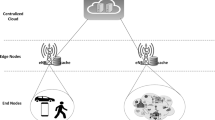Abstract
There has been a rapid growth in the need to support mobile nodes in IPv6-based networks. IETF has completed to standardize Mobile IPv6 (MIPv6) and Hierarchical Mobile IPv6 (HMIPv6) for supporting IPv6 mobility. Even though existing literatures have asserted that HMIPv6 generally improves MIPv6 in terms of handover speed, they do not carefully consider the details of the whole handover procedures. In this paper, based on the current IETF standards of both MIPv6 and HMIPv6, we conduct a comprehensive study of all IP-level handover procedures: movement detection, duplicate address detection, and location registration. Based on this study, we provide a mathematical analysis on MIPv6 and HMIPv6 performance in terms of handover speed. From the analysis, we reveal that the average HMIPv6 handover latency is not always lower than the average MIPv6 handover latency. Furthermore, even the intra-domain handover latency of HMIPv6 is not reduced much compared with MIPv6 handover latency. A finding of our analysis is that optimization techniques for movement detection and duplicate address detection are essential to shortening HMIPv6 handover latency and increasing the benefit of HMIPv6.
Similar content being viewed by others
Abbreviations
- aDAD:
-
Advance duplicate address detection
- AR:
-
Access router
- BAck:
-
Binding acknowledgement message
- BU:
-
Binding update message
- CN:
-
Corresponding node
- CoA:
-
Care-of address
- CoT:
-
Care-of test message
- CoTI:
-
Care-of test initiation message
- DAD:
-
Duplicate address detection
- HA:
-
Home agent
- HMIPv6:
-
IETF hierarchical mobile IPv6
- HoA:
-
Home address
- HoT:
-
Home test message
- HoTI:
-
Home test initiation message
- LBU:
-
Local binding update message
- LCoA:
-
Local care-of address
- MAP:
-
Mobility anchor point
- MD:
-
Movement detection
- MIPv6:
-
IETF mobile IPv6
- MN:
-
Mobile node
- NA:
-
Neighbor advertisement message
- NS:
-
Neighbor solicitation message
- oDAD:
-
Optimistic duplicate address detection
- RA:
-
Router advertisement message
- RCoA:
-
Regional care-of address
- RS:
-
Router solicitation message
References
Aboba, B. (2005). Architectural implications of link indications. IETF Internet draft, draft-iab-link-indications-04.txt (work in progress).
Castelluccia C. (2000). HMIPv6: A hierarchical mobile IPv6 proposal. ACM Mobile Computing and Communications Review 4(1): 48–59
Choi, J., & Daley, G. (2005). Goals of detecting network attachment in IPv6. IETF RFC 4135.
Han, Y.-H., Choi, J., Jang, H., & Park, S. (2003). Advance duplicate address detection. IETF Internet draft, draft-han-mobileip-adad-01.txt (work in progress).
Han, Y.-H., Hwang, S.-H., & Jang, H. (2004). Design and evaluation of an address configuration and confirmation scheme for ipv6 mobility support. In: Proceedings of IEEE Wireless Communications and Networking Conference (WCNC).
Hsieh, R., Seneviratne, A., Soliman, H., & El-Malki, K. (2002). Performance analysis on hierarchical mobile IPv6 with fast-handoff over end-to-end TCP. In: Proceedings of IEEE Global Telecommunications Conference (GLOBECOM 2002), Vol. 3. pp. 2488–2492.
Johnson, D. B., Perkins, C. E., & Arkko, J. (2004). Mobility support in IPv6. IETF RFC 3775.
Lee Y.-J. and Akyildiz I.F. (2003). A new scheme for reducing link and signaling costs in mobile IP. IEEE Transactions on Computers 52(6): 706–713
Moore, N. (2005). Optimistic duplicate address detection. IETF Internet draft, draft-ietf-ipv6-optimistic-dad-05.txt (work in progress).
Nartan, T., & Draves, R. (2001). Privacy extensions for stateless address autoconfiguration in IPv6. IETF RFC 3041.
Narten, T., Nordmark, E., & Simpson, W. (1998). Neighbour discovery for IP version 6. IETF RFC 2461.
Pack, S., & Choi, Y. (2003). Performance analysis of hierarchical mobile IPv6 in IP-based cellular networks. In: Proceedings of IEEE Personal, Indoor and Mobile Radio Communications (PIMRC 2003). pp. 2818–2822.
Perez-Costa, X., Schmitz, R., HArtenstein, H., & Liebsch, M. (2002). A MIPv6, FMIPv6 and HMIPv6 handover latency study: Analytical approach. In: Proceedings of IST Mobile and Wireless Telecommunications Summit.
Perez-Costa, X., Torrent-Moreno, M., & Hartenstein, H. (2003). A performance comparison of mobile IPv6, hierarchical mobile IPv6, fast handovers for mobile IPv6 and their combination. In: ACM SIGMOBILE Mobile Computing and Communications Review, Vol. 7. pp. 5–19.
Soliman, H., Castelluccia, C., Malki, K.-E., & Bellier, L. (2005). Hierarchical mobile IPv6 Mobility management (HMIPv6). IETF RFC 4140.
Thomson, S., & Narten, T. (1998). IPv6 stateless address autoconfiguration. IETF RFC 2462.
Vaughan-Nichols S.-J. (2003). Mobile IPv6 and the future of wireless internet access. IEEE Computer 36(2): 18–22
Xie, J., & Akyildiz, I. (2002a). A distributed dynamic regional location management scheme for mobile IP. In: Proceedings of IEEE INFOCOM 2002, Vol. 2. pp. 1069–1078.
Xie J. and Akyildiz I. (2002). A novel distributed dynamic location management scheme for minimizing signaling costs in mobile IP. IEEE Transactions on Mobile Computing 1(3): 163–175
Yegin, A. (2005). Link-layer event notifications for detecting network attachments. IETF Internet draft, draft-ietf-dna-link-information-01.txt (work in progress).
Author information
Authors and Affiliations
Corresponding author
Rights and permissions
About this article
Cite this article
Han, YH., Min, SG. Performance Analysis of Hierarchical Mobile IPv6: Does it Improve Mobile IPv6 in Terms of Handover Speed?. Wireless Pers Commun 48, 463–483 (2009). https://doi.org/10.1007/s11277-008-9533-y
Received:
Accepted:
Published:
Issue Date:
DOI: https://doi.org/10.1007/s11277-008-9533-y




